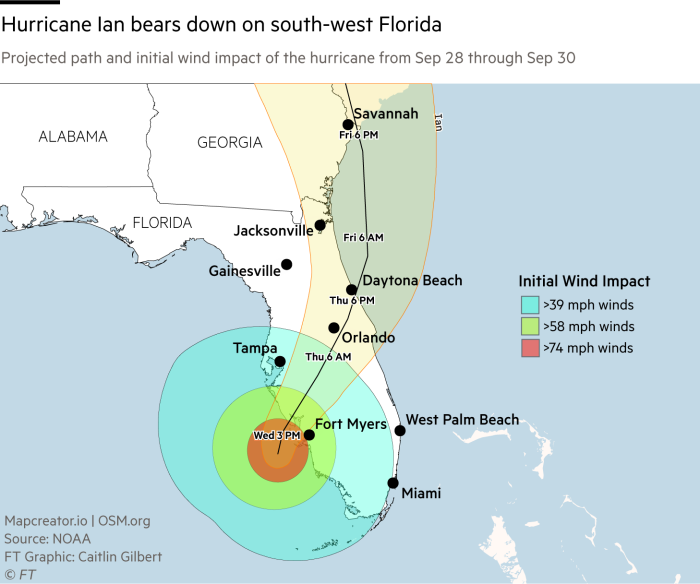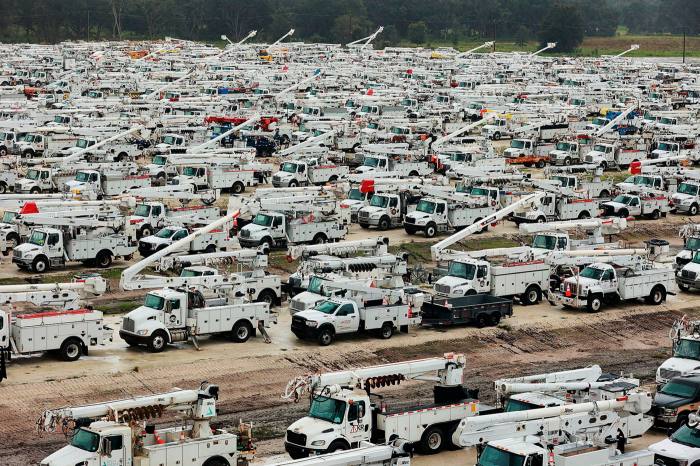More than 1.8mn people in Florida are estimated to be without power after Hurricane Ian ploughed into the south-west of the state on Wednesday, inundating the coastline and tearing through infrastructure and property, according to PowerOutage.US, a website tracking power cuts across the country.
Hurricane Ian made landfall at about 3.05pm Eastern time and was causing “catastrophic storm surge, winds, and flooding”, the National Hurricane Center said. With maximum sustained winds of 150mph, it was rated a category four storm, the second-strongest classification in meteorologists’ five-tier scale.
Florida governor Ron DeSantis warned that the storm would continue to move across the state on Thursday, causing “major, major impacts”.
“This storm is doing a number on the state of Florida,” DeSantis said.
Millions of Florida residents had been under evacuation orders, although on Wednesday morning, DeSantis said it was too late to leave Collier, Lee, Sarasota and Charlotte counties, where the storm was approaching.
Florida Power & Light, the state’s largest power utility, warned of “extensive damage to the electrical infrastructure” and predicted that parts of its system would need to be rebuilt after Ian passed through the state.

The “devastating” Ian will be “a storm we talk about for many years to come”, said Ken Graham, director of the National Weather Service.
Storm surges reaching between 12ft and 18ft were expected to hit the coast from Englewood to Bonita Beach, the US National Weather Service said. Tampa Bay, however, was drained on Wednesday morning as the hurricane’s counterclockwise winds blew out towards the sea.
Collier County, in south-west Florida, imposed a mandatory overnight curfew beginning at 10pm on Wednesday night, with local officials warning residents to stay away from flood water.
Videos posted on social media showed destructive flooding in the town of Naples, Collier County, leaving firefighters battling to save their equipment.
US president Joe Biden said he had been in touch with DeSantis to say the federal government would do everything it could to help Florida cope with the impact of the storm.
The US Federal Emergency Management Agency has sent 700 officials to Florida and brought 3.5mn litres of water and 3.7mn meals to nearby Alabama, as well as having generators on hand and 128,000 gallons of fuel “ready for rapid deployment”, said Deanne Criswell, the agency’s director.
Fema has also deployed 300 ambulances and federal medical teams to Florida and was tracking medical needs across the state’s hospitals, care facilities and dialysis centres.

Search and rescue co-ordination teams were on hand in Miami alongside the US coastguard, officials from the Department of Defense and the Department of the Interior. DeSantis ordered the deployment of 5,000 members of the Florida National Guard, with an extra 2,000 expected from other states.
Federal officials were already dealing with the devastation caused by Hurricane Fiona in Puerto Rico, which killed more than a dozen people and left hundreds of thousands without power.
Graham of the National Weather Service said the storm would slow as it moved over land, increasing the amount of rainfall produced. Parts of the state are forecast to receive between 15in and 24in of precipitation.
He said that, while the leading cause of fatalities in strong hurricanes was flooding, the storm’s eyewall should be expected to cause a “devastating” amount of structural damage to buildings and power lines.
Climate Capital

Where climate change meets business, markets and politics. Explore the FT’s coverage here.
Are you curious about the FT’s environmental sustainability commitments? Find out more about our science-based targets here






















![‘Chicago Med’ Recap Season 10, Episode 8 — [Spoiler] Dead or Alive ‘Chicago Med’ Recap Season 10, Episode 8 — [Spoiler] Dead or Alive](https://tvline.com/wp-content/uploads/2024/11/chicago-med-recap.jpg?w=650)
























































